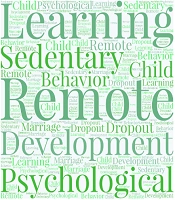Dear Editor,
The coronavirus disease 2019 (COVID-19) pandemic is transforming societies and worsening socio-economic inequalities in its wake. In a trial to control its spread, governments around the world have moved to suspend face-to-face teaching in schools (1). School closure minimizes interactions among students, which potentially limits COVID-19 transmission (2), though the available data shows that children and adolescents are less susceptible to it than older adults (3). Although costs and benefits are insufficiently known, school closure has an immense impact on students’ learning, especially in those from disadvantaged families (1).
According to the United Nations Educational, Scientific, and Cultural Organization (UNESCO), schools have been suspended nationwide in 188 countries, and over 90% of enrolled students worldwide are now out of education (4). According to the United Nations International Children's Emergency Fund (UNICEF), 1.6 billion students in 199 countries worldwide have been affected by school closures since the beginning of the pandemic (5). According to the United Nations (UN), school closure is affecting some 95% of the world’s student population, which is the largest disruption to education in history (6). Since educational establishments closed in March 2020, nearly 38 million students in Bangladesh have lost the opportunity to receive proper learning and interact with their peers, which has affected their educational experience (World Bank) (7).
School not only offers academic learning but also provides an ideal and healthy environment for students to achieve cognitive development, social interactions, emotional skills, psychological wellbeing, and adjustment as well as behaviors that transform into positive real-life health outcomes. These usually occur through the interconnection among friends, peers, and teachers (8, 9). School routines allow students to have regular bed/wake times and physical activity and restrict sedentary behaviors and non-educational screen time (television, video games, internet, mobile phones) (10, 11). Schools play an essential role in health and nutrition services, too (5).
Following the COVID-19 pandemic, schools were closed, and digital home schooling was introduced worldwide. Consequently, the government of Bangladesh commenced remote learning through radio, television, mobile phones, computers, etc. However, not all students have access to these resources, especially the Internet. A World Bank study found that < 50% have access to these devices, and most of them have access to mobile phones, but not the Internet due to various limitations. Another survey exhibited that of the 21% of households with access to online learning programs, only 2% used them. In the pre-pandemic era, 58% of Bangladeshi children did not achieve the minimum reading proficiency by the end of grade 5, which increased to 76% during school closures (7).
Strict physical distancing due to prolonged school closure poses a grave threat to the physical and mental wellbeing of students. It increases anxiety, loneliness, stress, sadness, frustration, indiscipline, daily screen time, and breakdown in daily routines. Besides, it lessens daily physical activity which aggravates sedentary behavior, resulting in overweight and obesity. A number of students with disabilities lost access to school-based healthcare services (12). According to the UNICEF, in 2020 an estimated 39 billion in-school meals have been missed globally (5). As the pandemic continues, a good number of students are not getting proper support due to parental unemployment, economic uncertainty, and/or family violence (4). Economic shock may force children to work and generate income for their families, which may raise the dropout rates (13).
Bangladesh has the 4th highest prevalence of child marriage in the world. According to the UN, the child marriage rate in Bangladesh is 51%, and 10 million additional girls are at risk of child marriage due to COVID-19, according to the UNICEF (08 March 2021). School closure, economic stress (e.g., joblessness, poverty, and food scarcity), fear and insecurity among parents, and parental death due to the pandemic place girls at a heightened risk of child marriage (14, 15). School dropout has been reported to be associated with child marriage (16). The crisis might deepen if there is a further delay in reopening schools.
School closure is gambling with the future of millions of students in Bangladesh, and it will cost a lot to mitigate the loss.
